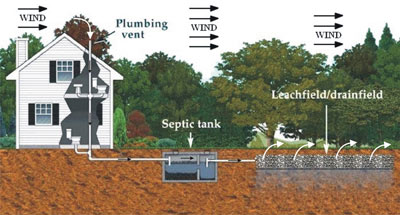BUILDING SCIENCE
The Building Science of Septic Drain Fields
By Gary Sharp
Septic drain fields, also called leach fields or weeping beds, are extremely important in treating wastewater. The septic tank offers a level of primary treatment while the drain field and soil beneath provide the final treatment before the water re-enters the ground water system.

Typical trench design drain field.
Traditionally, the fields are most often a number of independent trenches connected by a header pipe, but the principles involved apply to all drain fields.
How Drain Fields Age
Wastewater moves from the septic tank to the field trenches, then flows through the stone until it reaches the soil. There, it is processed by naturally occurring soil bacteria. A biological mat (biomat) of wastewater solids and bacteria forms at the soil/stone interface and this thickens over time, and eventually blocks the movement of water into the soil. Water then ponds in the trench and the biomat begins to form on the sides of the trench.
Over time, the buildup of the biomat can seal the trench so that water cannot escape to the soil. When this occurs, wastewater flows out of the ground or on top of the septic tank, or-even worse-backs up into the house. At this point, the septic field has failed. About 90 per cent of field failures are due to biological clogging.

Can Failure Be Stopped or Reversed?
The drain field bacteria are aerobic; they require oxygen and use nutrients in wastewater as food. As bacteria process waste they create more bacteria, require more oxygen, and produce more carbon dioxide. Lack of oxygen in the drain field system is similar to lack of ventilation and fresh air in a room: Just as people get sleepy, so do the bacteria.
When the drainage trench is first installed, the oxygen level (in the spaces between the stones) is similar to that in air-about 21 per cent. After a few days, and even before any wastewater gets into the trench, the oxygen level drops to 19 per cent because of the naturally occurring soil bacteria breathing. Once wastewater is introduced into the system, the bacteria consume more oxygen and its levels drop to between 0 and 6 per cent.


Passive ventilation of the drain field.
Oxygen gets into the drainage field as a result of the vent stack on the house and its connection to the septic tank. The septic tank has an air space above the water line and the tank is connected to the pipes in the field. In the case of drain fields, we rely on the wind to provide the pressure difference that moves air into the drain field. This passive ventilation depends completely on wind pressure.
Obviously, it doesn't work very well since the oxygen content in the trench is less than 6 per cent when the oxygen level above ground is 21 per cent. As we know with housing, we can't rely on the wind to provide adequate ventilation for the occupants (or the bacteria!)
Within the drain trenches, bacteria die from lack of oxygen. Biomat is primarily dead bacteria. So we need to get oxygen to the bacteria. One solution is to add mechanical ventilation to force air into the drain field.
With mechanical ventilation, air fills the trench and, because it is under pressure, it creates turbulence and a pressure difference that reduces carbon dioxide buildup at the bottom of the trench by replacing it with oxygen-rich air. The bacteria respond to this by returning to the work of processing the wastewater and, as an added benefit, they consume the biomat.
Research has shown that the bacteria respond to this "oxygen rich" environment by increasing their numbers by up to 135 times over non-ventilated trenches. Also, different species of bacteria show up that are even better at processing wastewater. The result is better treatment of the wastewater and less chance of a drain field failure.
For generations we have been building septic systems that building science shows will fail, yet we are surprised when they do. There is no reason for a drain field to fail if ventilation is provided. The research supports this, and experience demonstrates that even "failed" systems can be recovered by adding mechanical ventilation.
One system specifically designed for ventilating drain fields is available from SoilAir. www.soilair.com. Check with your local building official to determine permit requirements for installation.
Gary Sharp is the Director of Renovator Services, CHBA.
External Links: Associations & Governments. Builders & Renovators . Manufacturers & Suppliers
Home . About Us . Subscribe . Advertise . Editorial Outline . Contact Us . Current Issue . Back Issues . Jon Eakes
© Copyright - Work-4 Projects Ltd.


